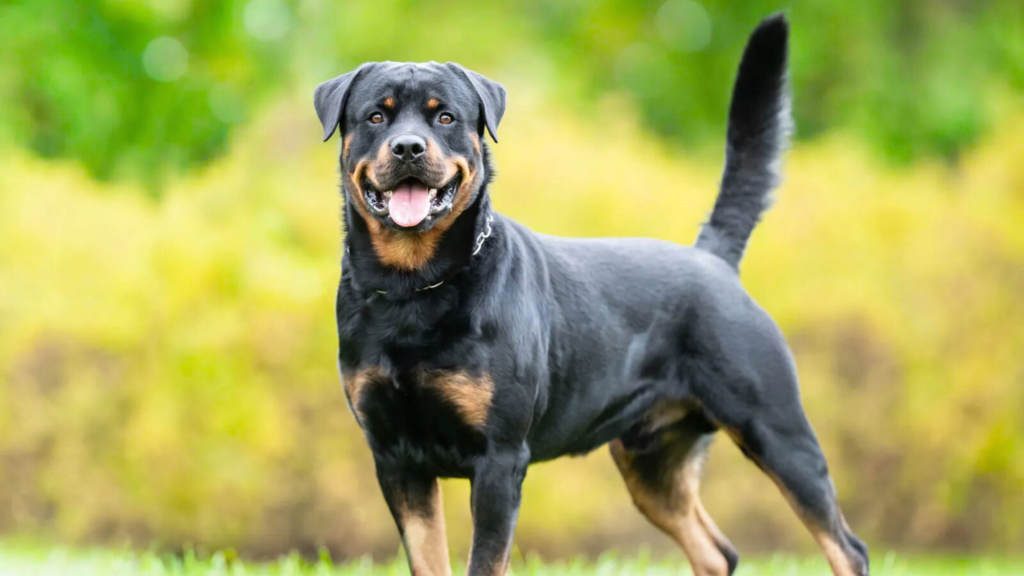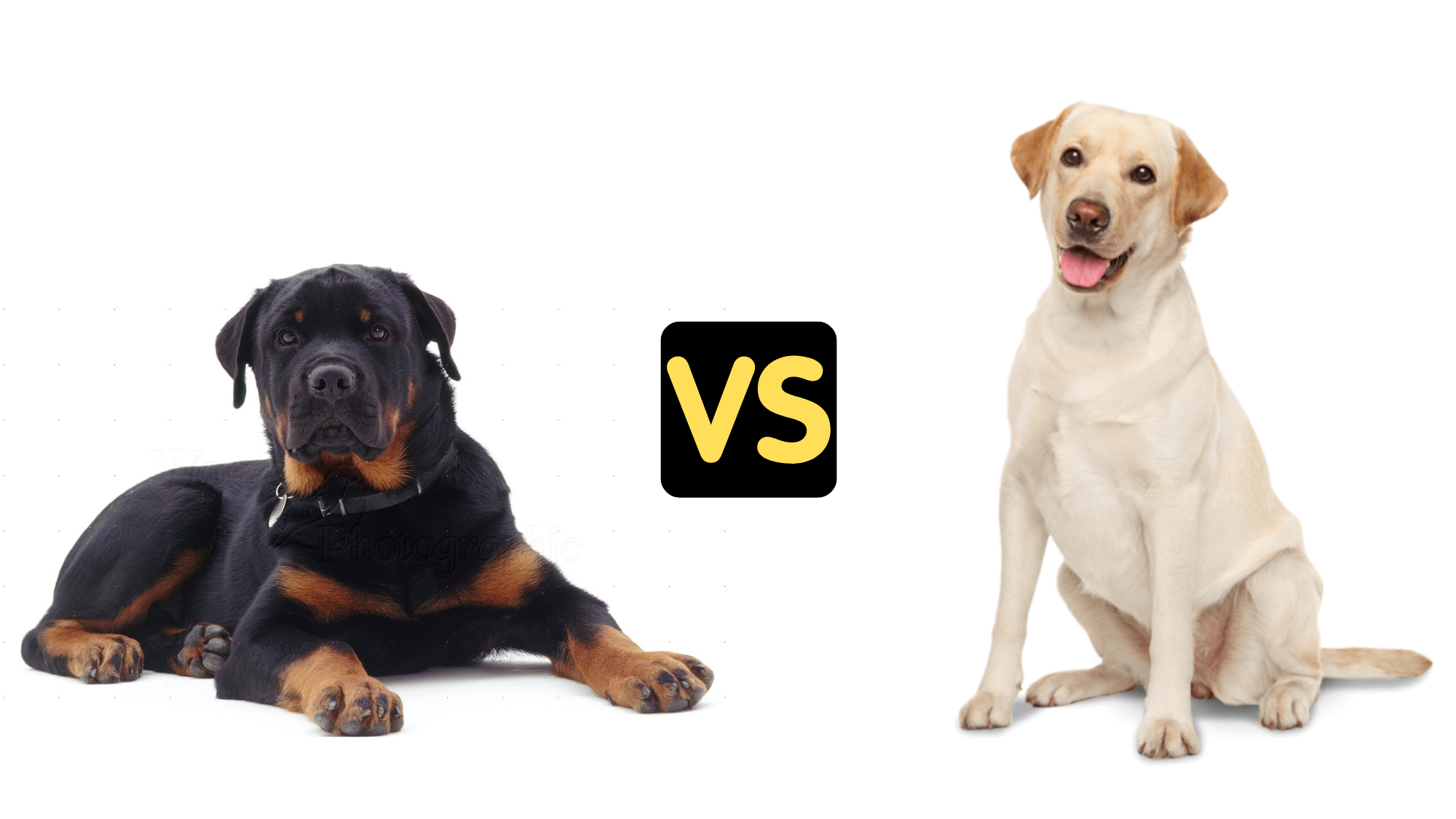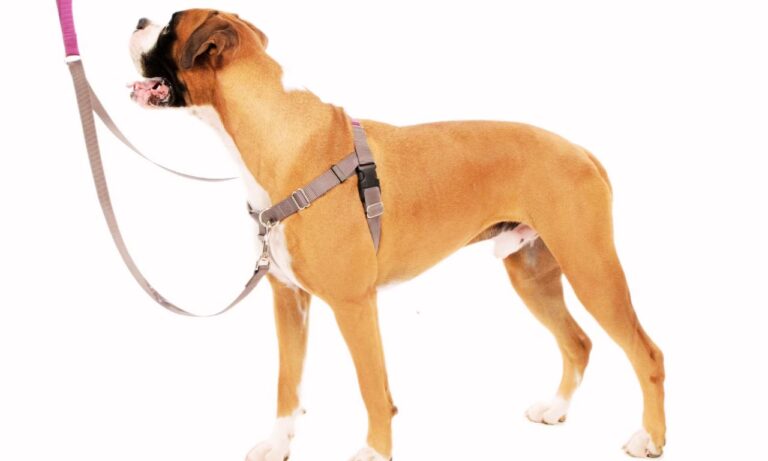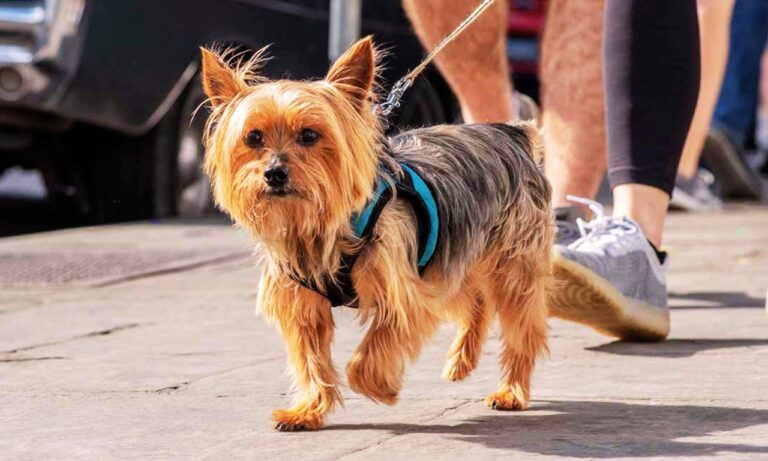When comparing the Rottweiler vs Labrador Retriever, you’re looking at two of the world’s most iconic breeds — but they come from very different backgrounds and were bred for very different purposes.
In terms of size, Rottweilers are heavier and stockier, built like natural tanks, while Labradors are lighter, more agile, and slightly taller in proportion to their leaner frames. Ensure your Newfoundland’s comfort and security with expert tips on how to ensure a safe collar fit for Newfoundland.
A male Rottweiler typically stands 24–27 inches tall and weighs between 95–135 lbs, while a male Labrador Retriever stands 22.5–24.5 inches and weighs around 65–80 lbs.
Despite these differences, both breeds are powerfully built and radiate physical strength — just in different ways.
If you’re trying to choose between them for your home, lifestyle, or even working needs, understanding their growth, size, structure, energy levels, and health tendencies will help you make an informed choice.
This guide breaks it all down — including growth charts, muscle composition, training needs, health risks, and overall life fit.
Blog Highlights
ToggleGrowth Rate: How Fast Do These Breeds Grow?
Both Rottweilers and Labradors grow rapidly in their first year, but the Rottweiler’s growth continues longer, especially in mass and muscle development.
Labs reach their full adult height earlier but continue to “fill out” into their second year, while Rottweilers can keep bulking into their third.

In the first six months, both breeds experience rapid weight gain, but the Rottweiler packs on noticeably more bulk, especially around the chest and shoulders.
Average Growth Chart (Male Comparison):
| Age | Rottweiler (Weight) | Labrador Retriever (Weight) | Rottweiler (Height) | Labrador Retriever (Height) |
| 2 Months | 20–28 lbs | 15–20 lbs | 10–12 in | 9–11 in |
| 4 Months | 45–60 lbs | 30–40 lbs | 16–18 in | 14–16 in |
| 6 Months | 65–80 lbs | 45–55 lbs | 20–22 in | 18–20 in |
| 9 Months | 80–100 lbs | 55–65 lbs | 22–24 in | 20–22 in |
| 1 Year | 90–115 lbs | 60–75 lbs | 24–26 in | 22–24 in |
| Full Grown | 95–135 lbs | 65–80 lbs | 24–27 in | 22.5–24.5 in |
Note: Female Rottweilers and Labradors are generally 10–20% lighter and 1–2 inches shorter than males.
Rottweiler: Muscular Powerhouse with Guarding Instincts
Originally bred as a drover’s dog in Germany, the Rottweiler’s ancestry includes ancient Roman mastiffs. Their body is built for strength, endurance, and protection.

Size Specs
- Adult Male Weight: 95–135 lbs
- Adult Male Height: 24–27 inches at the shoulder
- Adult Female Weight: 80–100 lbs
- Adult Female Height: 22–25 inches
Body Composition
Rottweilers are heavily muscled with deep chests, thick necks, and a broad stance. Their skeletal structure is heavy-boned, and they carry their weight low to the ground, giving them an unmistakable presence.
Despite their mass, a well-bred Rottweiler isn’t clumsy — they are surprisingly agile for their size. Their double-layered coat, often black with rust or mahogany markings, adds to their rugged, powerful look.
Most Rottweilers continue to thicken in bone and muscle between 18–30 months, with intact males developing particularly broad heads and chests.
Labrador Retriever: Athletic, Energetic, and Built for Endurance
The Labrador Retriever was developed in Newfoundland and refined in Britain for retrieving game in harsh conditions. Labs are versatile, all-purpose workers, built for stamina over brute strength.

Size Specs
- Adult Male Weight: 65–80 lbs
- Adult Male Height: 22.5–24.5 inches
- Adult Female Weight: 55–70 lbs
- Adult Female Height: 21.5–23.5 inches
Body Composition
Labs have a lean, athletic build with a strong chest, slightly tapered waist, and thick “otter tail” that aids in swimming.
Their skeletal frame is lighter than a Rottweiler’s but still very durable, designed to withstand hours of running, swimming, and retrieving.
Their coat is short, dense, and water-resistant, allowing them to perform in wet, cold conditions without issue. Discover the ideal fit by learning what size collar for Newfoundland dog to ensure your pet’s comfort and safety.
Compared to Rottweilers, Labs mature faster physically, though many owners note that Labs retain their “puppy-like” energy and mental immaturity well into adulthood.
Rottweiler vs Labrador Structural Comparison: Frame, Girth, and Gait
| Trait | Rottweiler | Labrador Retriever |
| Frame Type | Stocky, heavy-boned, broad | Lean, athletic, flexible |
| Gait | Deliberate, powerful strides | Smooth, ground-covering trot |
| Chest Width | Very broad | Moderately broad |
| Head Shape | Broad, square skull | More refined, wedge-shaped skull |
| Tail | Typically docked (in some regions) | Thick, “otter tail,” undocked |
| Neck | Thick and arched | Moderate thickness, longer |
Gait and Movement
- Rottweiler: Moves like a tank. Their gait is forceful, with deliberate, compact strides. When trotting or working, they display a confident, steady drive forward.
- Labrador: Moves like a runner. Their gait is fluid and efficient, covering ground quickly. Labs have an effortless stride that allows them to run and swim for hours without tiring.
Impact of Size on Training and Performance
Training both breeds is crucial, but their size and instincts affect how you approach it.
Rottweiler Training Insights:
- Requires firm, consistent leadership early on.
- Natural guarding instincts need early socialization to prevent overprotectiveness.
- Physical strength demands leash manners and structured obedience.
- Maturity can take longer, requiring extended patience.

Labrador Training Insights:
- Highly food-motivated and eager to please.
- Can be easily distracted due to high energy.
- Needs frequent mental stimulation (games, retrieving tasks, obedience drills).
- Responds best to positive reinforcement training methods.
How Size Affects Health and Longevity
Large breeds naturally face size-related health challenges, and both Rottweilers and Labradors are no exception.
Rottweiler Health Risks:
- Hip and elbow dysplasia (due to heavy bone load)
- Osteosarcoma (bone cancer risk higher than average)
- Aortic stenosis (heart condition)
- Obesity if not exercised properly
- Gastric torsion (bloat)
Average Lifespan: 8–10 years
Labrador Retriever Health Risks:
- Hip and elbow dysplasia
- Obesity (Labs love food — and it shows)
- Ear infections (due to floppy ears and love of water)
- Progressive Retinal Atrophy (PRA — an eye condition)
- Exercise-Induced Collapse (EIC) in some lines
Average Lifespan: 10–12 years
Note: Labradors generally enjoy a longer lifespan than Rottweilers due to their lighter frame and lower incidence of certain cancers.
For expert tips on how to fit a collar on a Belgian Shepherd, this guide offers simple steps to ensure your dog’s collar fits securely and comfortably.
Size and Lifestyle Fit: Which Breed Works for You?
Rottweiler in the Home:
- Best suited for homes with space, preferably a fenced yard.
- Thrives with owners who can provide firm leadership and consistent training.
- Prefers a stable, quiet environment — not a breed for chaotic households.
- Needs durable gear (strong crates, leashes, harnesses).
- May not be ideal for first-time dog owners.
Labrador in the Home:
- Highly adaptable — fits in apartments, suburbs, or country living if exercise needs are met.
- Ideal for active families, runners, swimmers, and outdoorsy owners.
- Very social; Labs crave human interaction and companionship.
- Requires lots of toys, mental stimulation, and regular outings.
- Great choice for first-time dog owners if time and energy are available.

Final Summary: Rottweiler vs Labrador — Which Breed Wins for You?
There’s no outright “winner” between the Rottweiler and the Labrador — only a better match for your lifestyle, experience, and goals. For detailed guidance on selecting the correct collar size for a Belgian Shepherd, this article provides essential tips to ensure your dog’s comfort and safety.
- The Rottweiler offers unmatched protection, loyalty, and power.
- The Labrador Retriever delivers endless energy, friendliness, and trainability.
If you want a guardian, a dog who will stand between you and any threat with silent authority, the Rottweiler is your breed.
If you prefer an all-around companion, ready for hiking, swimming, fetching, and cuddling, the Labrador Retriever will steal your heart — and probably your sandwich!
| Trait | Rottweiler | Labrador Retriever |
| Weight Range | 95–135 lbs (male) | 65–80 lbs (male) |
| Height Range | 24–27 inches | 22.5–24.5 inches |
| Growth Period | Up to 30 months | Up to 24 months |
| Body Type | Stocky, heavy | Athletic, lean |
| Speed & Agility | Moderate | High |
| Strength & Mass | Very High | Moderate |
| Lifespan | 8–10 years | 10–12 years |
Need More Help Choosing or Preparing for Your Dog?
Whether you’re getting a sturdy crate for your new Rottweiler or picking the perfect leash for an energetic young Lab, we can help! Ask about rottweiler vs labrador breed-specific gear recommendations for collars, food, toys, and even training tools.





